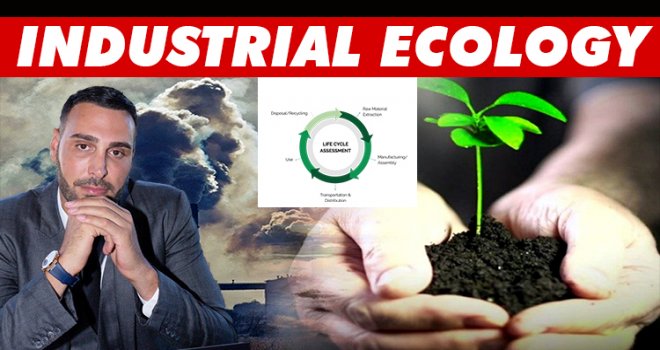

INDUSTRIAL ECOLOGY

Ecosystem Metaphor
Industrial ecology uses a metaphor that likens industrial fields of activity to ecosystems. In this case, making the waste materials of some become raw materials for others, thereby using the energy and material flows in natural ecosystems.
The industrial and regional ecology guide published by the Ministry of Sustainable Development in 2014, therefore, follows the famous example of industrial symbiosis. It encourages industrial sites to equip them with organized structures to consider the opportunities presented by the study of metabolisms.
This is not the first time that the flow of energy or materials between different companies has been formalized. However, it is based on a relationship characterized by ecologists as a symbiosis.
For the first time, an industrial zone is defined in the image of what is going on within an ecosystem. So, it's a mutually beneficial permanent natural association between two species.
And this has been turned into a success story: It provides meaningful figures in terms of economic efficiency (the investments are highly profitable) and environmentally. (energy saving, reduction of CO2 emissions, etc.)

According to some commentators, the industrial ecosystem has a formation mechanism. It is established on the basis of voluntary commitments of industrialists and commercial relations between different companies. It would be the fruit of spontaneous evolution, another biological metaphor.
However, if we carefully reconsider its history, which began in the early 1960s, three points are important.
First, there is the constructive presence of public actors and a shared effort over a long period of time. This contradicts the idea of spontaneous market regulation through a kind of invisible green hand.
Second, in terms of resources entering the ecosystem, an oil refinery and by-products of central industry actors may be needed by others. It is worth noting that it is a coal power plant that does not bode well for an energetic transition.
Third, the recovered heat and by-products are used in fish farming. Or exported to New Zealand for the manufacture of chemical fertilizers. Therefore, industrial ecology can lead to the reinforcement of a hyper-industrial system.
Ecological economists characterize enthusiasm for industrial ecology by pointing to the existence of rebound effects.
Since the beginning of the industrial revolution, there has been a decrease in costs due to the improvement of the performance of steam engines. Therefore, it has been observed that it encourages coal consumption to increase tenfold.
The same logic applies to consumer products, such as cars that use less fuel and emit less CO2 and are driven longer distances.
Reviews of the available literature point to a recovery effect resulting in a 10% to 30% increase in fuel consumption in some countries.
Therefore, a technological trajectory that is expected to be less damaging to the environment will lead to increased pressure on ecosystems and natural resources if not combined with other collective measures.

Life Cycle Analysis
Tools originating from ecological concepts can also be rejected at the product level. Life cycle analysis identifies all inbound and outbound flows of manufacturing processes at every stage of production by engineers. (water consumption, CO2 emissions, heavy metal emissions, etc.) It is a product evaluation tool used to connect these flows.
It makes it possible to determine the potential to reduce the use of resources and environmental damage, which is clearly dependent on the product unit analyzed, from the beginning of the product to the end of its life.
In the United States, the Environmental Protection Agency criticizes the enactment of binding public pollution reduction standards. In response to pressure from business lobbyists, it has adopted this method under the name of resource and environmental profile analysis.
From the 1990s, it became an environmental management tool associated with standards. These are structured in such a way that firms are free to commit and can decide on the environmental goal they set.
Yaşam Ayavefe
-
 KARAYOLLARI DAİRESİ, GÜVERCİNLİK VE SADRAZAMKÖY’DEKİ ÇALIŞMALARI TAMAMLADI..
KARAYOLLARI DAİRESİ, GÜVERCİNLİK VE SADRAZAMKÖY’DEKİ ÇALIŞMALARI TAMAMLADI..
-
 Arıklı, 23 Nisan Ulusal Egemenlik ve Çocuk Bayramı dolayısıyla mesaj yayımladı..
Arıklı, 23 Nisan Ulusal Egemenlik ve Çocuk Bayramı dolayısıyla mesaj yayımladı..
-
 Tosunoğlu: Vekil olmaktan mutlu değilim
Tosunoğlu: Vekil olmaktan mutlu değilim
-
 Dünyada israf edilen gıdalar, yetersiz beslenen insanların 2 katından fazlasına ..
Dünyada israf edilen gıdalar, yetersiz beslenen insanların 2 katından fazlasına ..
-
 YÖDAK’ın Araştırılması Komitesi Başkanı Hasan Küçük oldu
YÖDAK’ın Araştırılması Komitesi Başkanı Hasan Küçük oldu
-
 Oğuz: 3 ayda bin 462 kişiyi ülkeye almadık, 827 kişiyi deport ettik
Oğuz: 3 ayda bin 462 kişiyi ülkeye almadık, 827 kişiyi deport ettik
-
 Stefanu’dan Hristodulidis’e sert eleştiri: Kıbrıs sorununda izlediği çizgi esasl..
Stefanu’dan Hristodulidis’e sert eleştiri: Kıbrıs sorununda izlediği çizgi esasl..












